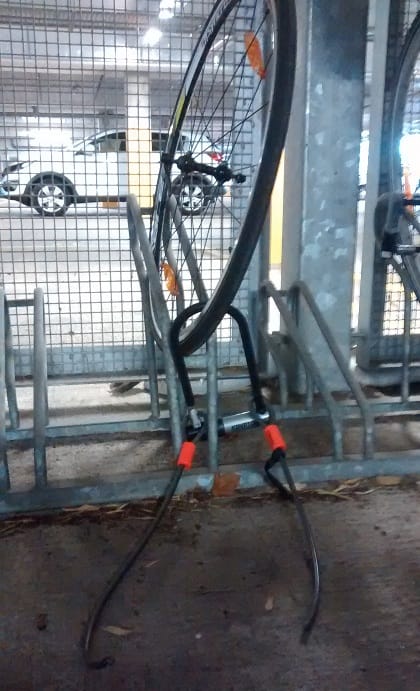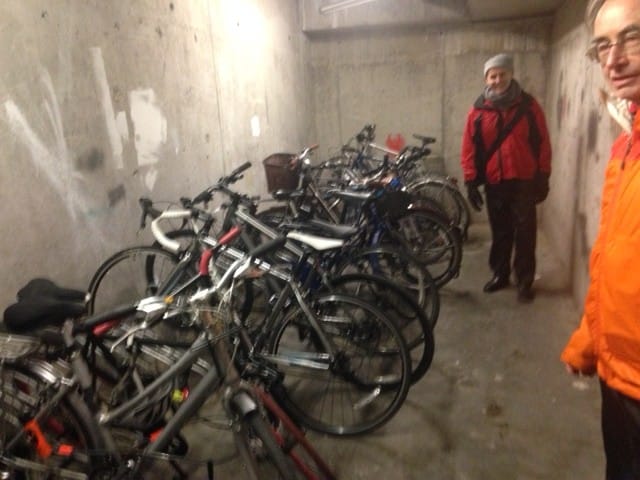What’s the best way to tell area residents about plans for a new asylum shelter nearby?
The government should tell communities directly about plans for new asylum shelters, some activists and politicians say.
The city needs more secure cycle parking – not just on the street, but also in apartment complexes. How can we get apartment-block owners to invest in it?

“My bike has become a ‘house bike’,” says Adrienne Hume.
Hume is a resident of a Shankill apartment complex where bike theft is common. She’s had one bike stolen and is afraid to lock up her new bike outside, where it could get stolen as well.
And she’s not willing to carry it in and out of her apartment every time she wants to use it. “It’s too heavy to carry up and down [the stairs] and it’s too big for the lift,” she says.
Which is what has led to her bike living a pretty lacklustre life in her apartment, instead of rolling free on the streets of Dublin as it was meant to.
Stories like Hume’s – about bike theft, and about a lack of cycle parking leading to a lack of cycling – are why providing cycle parking is starting to be seen not just as a way to manage bike storage in the city centre, but as a way to encourage more people to start cycling.
Some cycling advocates and apartment managers are calling on the government to bring in financial incentives for providing more effective, appealing and easily accessible bicycle parking in apartment complexes.
Perhaps this isn’t totally out of the question. There’s been talk, after all, of spending some money on better cycle parking.
A recently published report on cycle parking in the city centre, commissioned by Dublin City Council (DCC) and the National Transport Authority (NTA), calls for a €10 million investment in public cycle parking over the next 16 years.
This has pleased most cyclists, but one Dublin Cycling Campaign member has been calling for more focus to be put on the other end of the trip: cycle parking at people’s homes, particularly at apartment complexes.
David Timoney, a Dublin Cycling Campaign member who has researched bike theft in Dublin, says that providing safe parking at people’s homes might be just as important as providing public bike parking in the city.
This all goes back to a study the Cycling Campaign did last December. They surveyed 1,500 people about bike theft and got some unexpected results.
They found that roughly 16 percent of people who have a bike stolen gives up on cycling as a result. Another 26 percent of respondents cycled less after their bike was stolen. So, overall, the survey found that 42 percent of people who had their bike stolen stopped cycling or cycled less.
The Cycling Campaign estimates that more than 20,000 bikes a year are stolen in Dublin. Based on the survey results, we might expect 8,400 of these bicycle owners, which is 42 percent, to stop cycling or cycle less.
This at a time when Dublin needs more people cycling, to ease road congestion and reduce the country’s carbon emissions.
And where are these bicycles being stolen from? “Over a third of bikes being stolen in Dublin were taken from apartment car parks,” Timoney says.
In fact, more bikes are stolen from underground car parks than from off the street. Although streets are not that far behind, as the next most likely place bikes are stolen from, followed by people’s sheds and back gardens.
Perhaps it should not be a surprise that so many bikes are stolen from apartment car parks.
Timoney and some Cycling Campaign colleagues visited about 30 apartment blocks in Dublin to talk to residents, caretakers and apartment-management companies and scrutinise their bike-parking facilities.
“Just by observation,” Timoney says, “You could see that the bike-parking facilities are just not fit for purpose.”
On a rain-drenched Thursday last week, Timoney set up a tour of three apartment buildings in the docklands to get an idea of how to do – and how not to do – cycle parking.
In attendance were: Green Party Dublin city councillor Ciaran Cuffe, who chairs a bike-theft group involving DCC, the Cycling Campaign, the NTA and An Garda Síochána; Bryan Maher, a director of an apartment-management company; and three residents of the buildings we were having a look at.

One of the pitfalls of wheel racks.
The first complex we visit is Hanover Quay. The caretaker takes us on a tour of the complex’s many formal and informal bike-parking locations, above and below ground.
The first point Timoney brings up is that all the bike racks at the complex are of the wheel-locking variety, instead of the preferred “Sheffield” type, which looks like an upside down “U” reaching about to about hip height.
When only one wheel can be fastened, a bike is less secure, because a thief can remove the fastened wheel, or cut through its spokes, to free the bike’s frame and its other wheel. And, one of the residents adds, if a bike gets a nudge from the side, its wheel could buckle.
The caretaker leads us to a dark, locked concrete room about as far away from any ramp or stairs as you could get in the car park. Inside the room is the complex’s secure bike-parking facility.
Timoney observed that although the bikes are probably safe, it doesn’t feel like a safe place. Locating the room in a far-flung corner of a maze like car park, far from any natural surveillance certainly didn’t help.
To reassure us, the caretaker explains that it is under surveillance. Still, it didn’t feel safe, and if it doesn’t feel safe, that might put people off using it.

One of the building’s residents accompanying us later shared that his partner didn’t use the room, referring to it as the “rape room”.
It’s also inconveniently located. A Hanover Quay resident accompanying us explained why he didn’t use the room.
“I want quick access to my bike,” the resident said. “I want to get a preferential location close to the door. It needs to be handy. I end up parking my bike outside just so I can come and go quickly.”
The next apartment building was Gallery Quay, which was much the same as Hanover Quay in terms of cycle parking. The caretaker of Gallery Quay indicated that bike theft was indeed an issue there.
With over 300 apartments, we were surprised to find only a few token wheel racks scattered around. The bikes that were in the car park were mainly locked to a pipe running along a wall next to the ramp up to street level.
Aoife, a resident of the the apartments, has had more than her fair sure of theft.
“For my husband’s birthday, we bought a brand new bike, it was over €700. I think he used it once,” she says. They left it in one of the wheel racks downstairs and went for a weekend getaway. When they came back, it was gone.
Not long after that, Aoife’s bike was stolen as well, “I had to leave it in the lobby for a minute,” she says, to grab something from the store.
Now Aoife keeps her new bike in their apartment. “You’re not supposed to have your bike on the balcony,” she says, so she keeps it in their hallway, which makes things awkward.
Rather than lug her bike up and down the stairs everyday, Aoife just uses a Dublin Bike from the stand outside most days. She thinks it might be different if there was some sort of a bike shed that required a key to get into.
Funny enough, that’s what we saw at the next place.
At the Gasworks development, next to the Google office on Barrow Street, bike parking permeated the campus. And it was on the ground floor, rather than underground. There were bike-parking areas near the complex’s many entrances, and they required a key available only to bike owners.
In the Gasworks, we didn’t spot any bikes on balconies, as we had in the other apartments we toured. But all the secure ground-floor parking areas were well used.
Timoney took a few lessons from this.
“The bike parking that was used the most,” he said over coffee after the tour, “was the one that was above ground. It was bright, there was natural surveillance, and there was a cage, but you could see straight into it.”
One of the major takeaways from the tour, said Timoney, was that easy accessibility seems almost as important as security when it comes to bike parking.
Adrienne Hume, the owner of the house bike in Shankhill, says she’d probably be laughed off if she suggested – at her apartment complex’s next management meeting – spending their limited money on secure cycle parking.
“We have so many things that we need to spend our money on,” says Hume. “We can’t even get some sort of enclosed unit for our bins at the moment.”
Bryan Maher, director at the Rathborne Management Company, and member of the Apartment Owners Network, also said bringing in better cycle parking would be difficult.
He says bike theft is a problem at his apartments. But there are two big obstacles between management companies and retrofitting apartment complexes with better cycle parking.
“There’s the finance to be able to do it and then there’s the know-how as to what to do,“ he says.
“Management companies often struggle to raise money and to collect service charges,” says Maher. “Therefore they are very nervous, when it comes to actually spending money, about doing it right.”
It would be easier to assuage the worries of the management company and the residents, explains Maher, if there were some kind of design manual that laid out the best practices for building cycle-parking facilities in an apartment complex.
Timoney says that while general guidelines for cycle parking exist in the National Cycle Manual, creating a more detailed guide for retrofitting apartment building car parks is something the Bike Theft Group is considering.
As for money, management companies have a lot of different things to spend money on and a lot of different people to please, not all of whom cycle, Maher says. So setting aside a lot of money for high-quality cycle parking would be a tough sell.
Timoney isn’t sure exactly how much it would cost to retrofit an apartment complex with high-quality cycle parking. “Economies of scale are involved,” he says. The stands themselves are only about €60 a pop, but installation could cost a bit, and building cages around them would cost a bit more.
He thinks it could become a much easier, though, if the government offered some sort of grant to retrofit apartment parking areas with high-quality cycle parking.
“We’ve got ambitious carbon-reduction targets and cycling obviously helps with that,” Timoney says. “We have potential health benefits and a traffic-congestion problem. It makes sense to put in place some sort of incentive scheme.”
Get our latest headlines in one of them, and recommendations for things to do in Dublin in the other.